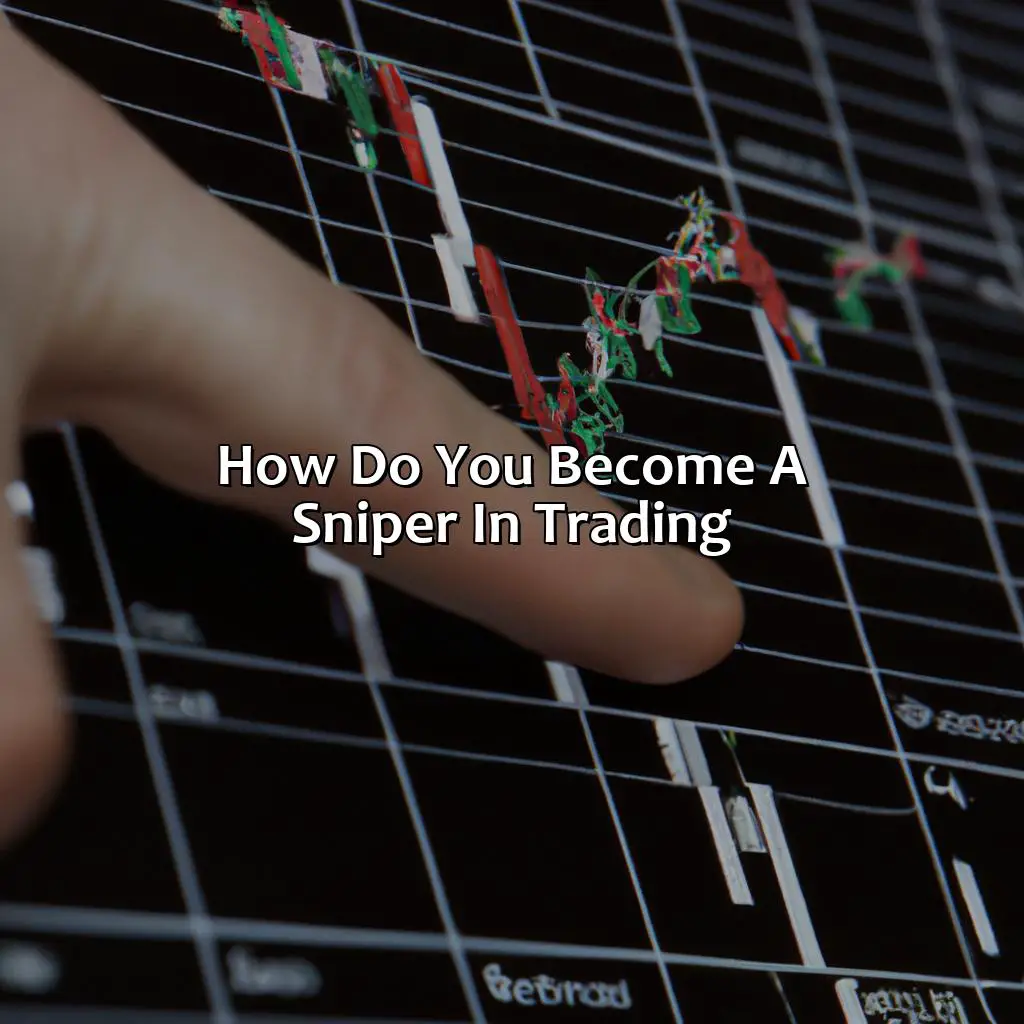
Key Takeaway:
- Sniper trading requires a sniper mentality: Successful trading involves a long-term mindset, emotional control, discipline, patience, adaptability, consistency, and perseverance. Traders should develop strong analytical skills and risk management strategies to gain a trader’s edge and earn profits.
- Traders should develop a trading plan with clear goals, strategies, and risk management rules. A trading plan should include a trading journal, backtesting and forward testing, position sizing, and execution strategies using market orders, limit orders, stop orders, and trailing stops.
- To become a sniper in trading, traders should identify the right markets using market analysis and identifying trends, reviewing historical data, and focusing on liquidity, transaction costs, and other factors. Traders should also choose suitable trading tools and strategies, such as technical analysis, fundamental analysis, chart patterns, indicators, and trading software, to optimize their trading performance.
What is Sniper Trading?
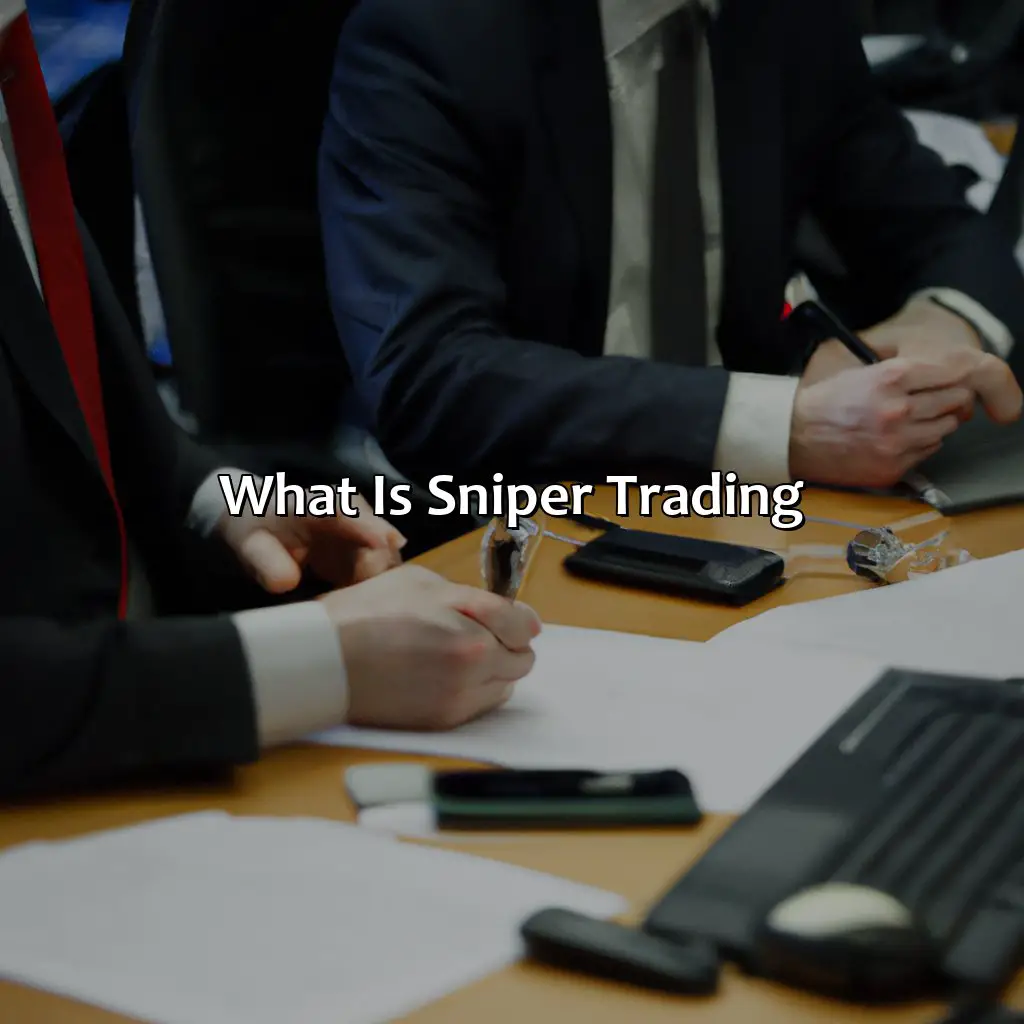
Photo Credits: forexbrokerreport.com by Patrick Nguyen
Sniper Trading is a form of trading that involves using technical analysis to identify entry and exit points for trades. This strategy focuses on precision and patience, waiting for the perfect opportunity to make a trade. By analyzing chart patterns and market trends, traders can identify the ideal moments to enter and exit positions. This approach requires traders to use a strict set of rules and a well-defined trading system to manage risks, including setting stop-loss and profit target levels. The goal is to make controlled, informed trades that have a higher likelihood of success, rather than making impulsive decisions based on emotions.
To become a successful sniper trader, it’s important to develop effective trading strategies that incorporate technical analysis and chart patterns. These strategies should include rules for identifying entry and exit points based on specific market conditions. Additionally, traders must be disciplined and patient, waiting for the right opportunities rather than acting impulsively. Traders should also be willing to adapt their strategies as market conditions change, continually refining their system based on experience and analysis. Finally, it’s important to have a clear understanding of risk management techniques and tools, including setting stop-loss levels to protect against significant losses.
Practicing these principles and consistently following a well-defined trading system can help traders become more confident and successful sniper traders over time. By using a disciplined, patient approach and incorporating technical analysis and risk management techniques, traders can improve their chances of success and achieve their trading goals.
Some Essential Skills for Sniper Trading
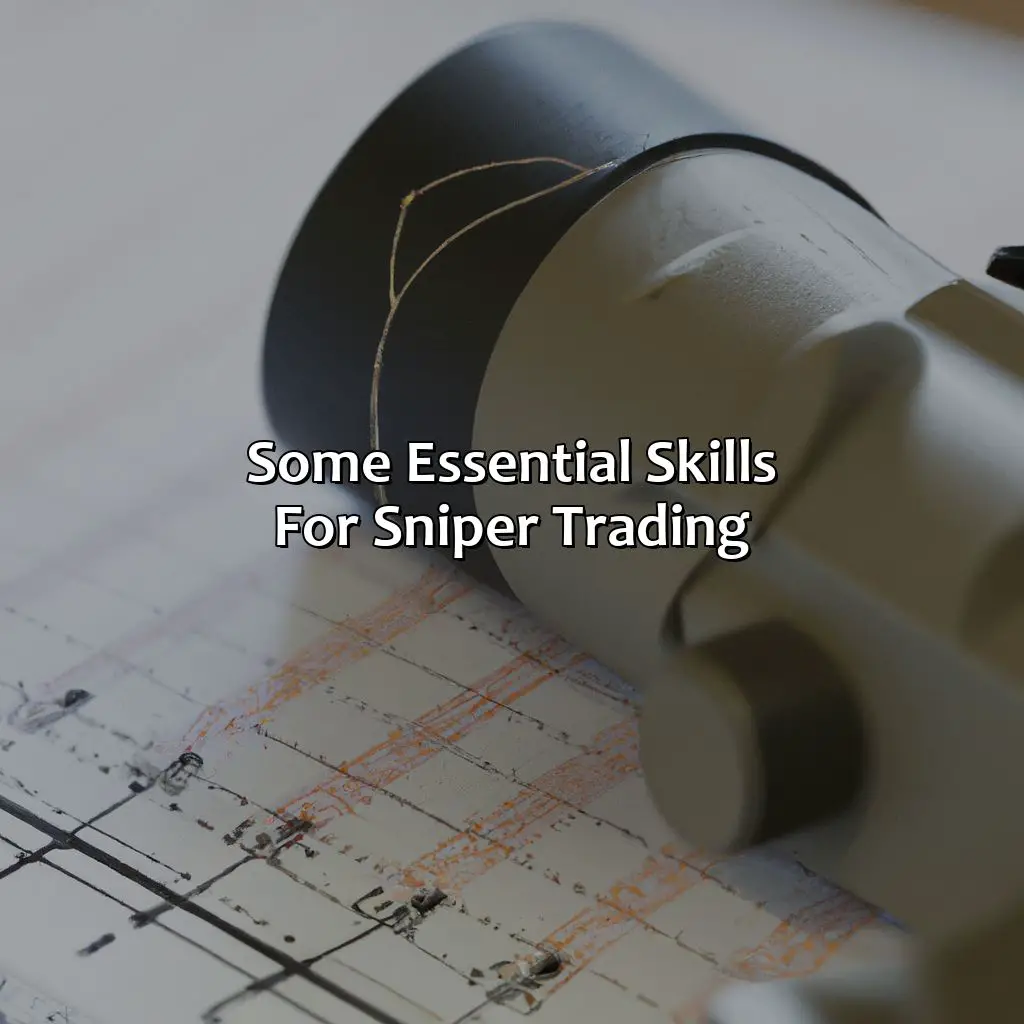
Photo Credits: forexbrokerreport.com by Gregory Thomas
Developing a sniper mentality in trading requires essential skills. These include strong analytical skills such as market and trend analysis, price action, risk-reward ratio, and position sizing. Risk management is also vital. This involves stop-loss, profit target, and trade management. You need to be patient and disciplined to keep a long-term focus and control your emotions. Self-awareness and continuous learning are required too. Plus, evaluation and feedback are key to success.
Strong Analytical Skills
The ability to accurately analyze market trends and price action is crucial for successful trading. Advanced market analysis skills are essential to identify profitable opportunities. Identifying the most reasonable entry and exit points for every trade, assessing the risk-reward ratio, and optimal position sizing all require strong analytical abilities. As a sniper trader, you need to be able to make quick and accurate decisions based on data from various sources such as news feeds or technical indicators.
To improve analytical skills, traders must have extensive practice in market analysis, including trend analysis and price action reading. This requires the use of various tools such as chart patterns, technical indicators, fundamental analysis and economic calendars.
Moreover, skilled traders should know how to assess macroeconomic conditions that might influence currency movements or stock prices. Therefore extensive knowledge of current political situations, international events or economic policy changes would help you form a more holistic picture of global economic activity.
Traders undergo continuous education themselves in the financial industry through courses online educational resources or discussion forums for sharing experiences.
One notable success story comes from Paul Tudor Jones II who started off as an options trader using only technical signals back in the early 80s before he built up a net worth surpassing $5bn within 20 years through his Macro Trading strategy.
Risk management is like having a sniper’s scope – set your stop-loss, profit target, and risk-reward ratio, and let trade management and position sizing do the aiming.
Risk Management
Effective management of financial exposure is essential in achieving trading success. In Sniper Trading, minimizing losses and maximizing profits come as a result of impeccable risk management. Properly handling risk is pivotal for securing positions and gaining returns.
To manage risks, traders must have a viable strategy that includes stop-loss orders, profit targets, risk-reward ratios, position sizing and trade management rules. By employing these tactics when setting up trades, traders limit the amount they can lose if the trade goes against them while giving themselves room to make significant gains if it succeeds.
Additionally, the usage of stop-loss orders ensures a trader exits from an unprofitable trade before losing too much capital. Profit targets set limits ensure a trader will take profits at predetermined levels to optimize their returns on successful trades. This protects them from making emotional decisions during price uptrends or downtrends and provides them with clear-cut goals.
By practising discipline in forex trading regarding position sizing and maintaining levelling check-ins helps keep away impromptu transactions that bring unnecessary losses have an edge over those non-strategic players. Proper risk management distinguishes successful traders from beginners who often leave everything to chance.
Patience in trading is not just waiting for the right moment, it’s also having the discipline to stick to your long-term mindset and emotional control in the face of market volatility.
Patience
Maintaining a long-term mindset is essential in sniper trading and requires patience, discipline, and emotional control. The ability to wait for the best opportunities to enter or exit trades can lead to higher profits. It also involves understanding that losses are part of the process and taking a strategic approach to manage risks effectively. As trading psychology plays an important role in successful trading, developing patience also includes managing emotions during profitable and non-profitable times.
In summary, patience is crucial in developing a successful trading plan that involves a long-term perspective combined with a disciplined approach to trading. According to Investopedia, lack of patience can cause missed opportunities and impulsive decisions resulting in significant financial losses.
Discipline is not just about following rules, it’s about mastering yourself and your emotions to make wise trading decisions.
Discipline
Maintaining trading discipline is a crucial aspect of successful sniper trading. Trading psychology plays a vital role in developing the required emotional control and self-awareness. Traders must evaluate their performance and receive feedback to identify areas for improvement continuously. Continuous learning helps traders make informed decisions and stay updated with market trends. Trading discipline ensures that traders stick to their trading plan and avoid making impulsive decisions based on emotions or external factors.
Creating a solid trading plan is like having a map in a jungle – it helps you navigate through the chaos and find your way to success.
Developing a Trading Plan
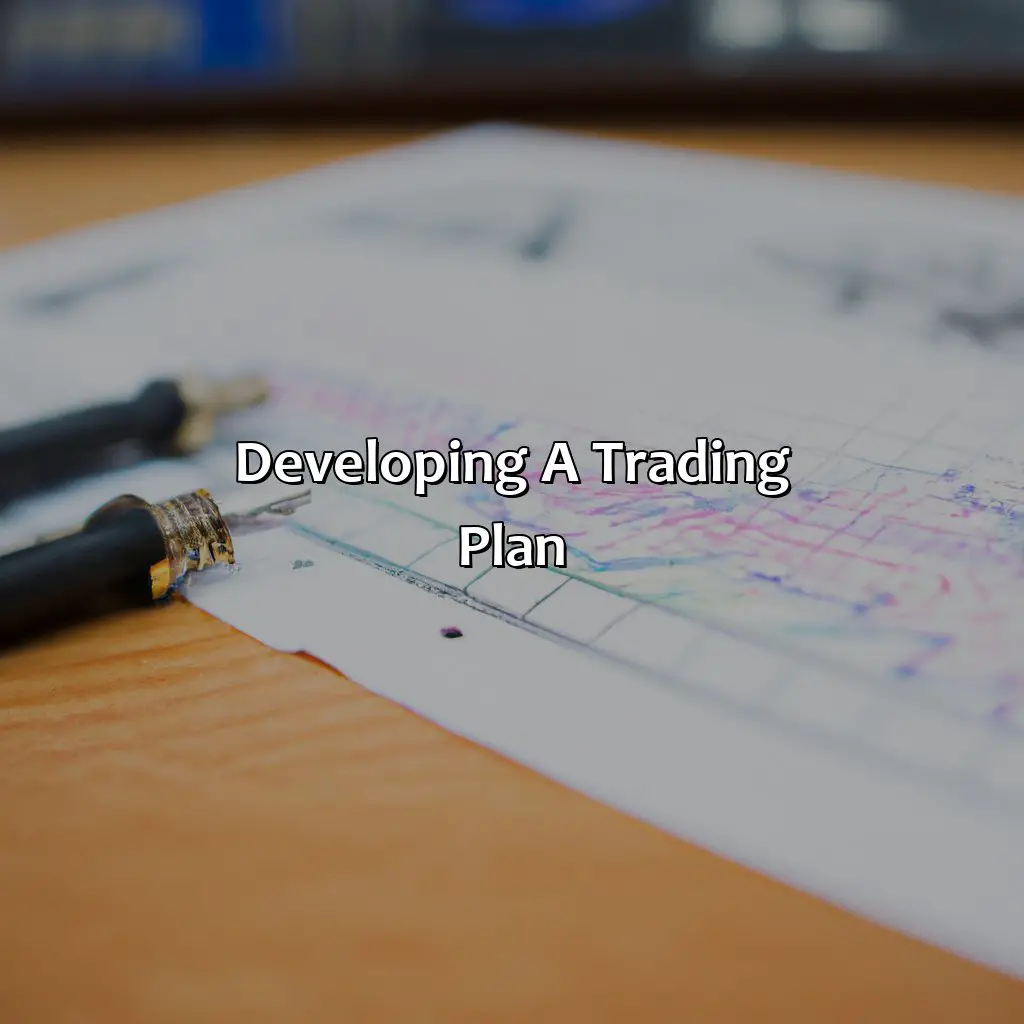
Photo Credits: forexbrokerreport.com by Douglas Harris
Develop a trading plan for success!
Define goals, strategies, and risk management rules.
- Analyze trends
- Assess risks
- Identify potential threats
Get to know market conditions, volatility, liquidity, news events, and economic indicators. Set up risk management rules and understand trade management strategies. Maximize profits and minimize risks. Become a sniper in trading!
Define Trading Goals
Developing a clear set of objectives is crucial in achieving success in sniper trading. Setting trading goals requires defining specific targets that traders aim to achieve, whether it be earning a certain percentage of profits or increasing the number of trades made per week. In addition to these goals, keeping an eye on risk management remains vital, as this helps traders stay protected from any potential hazards.
To establish profitable trading plans, market analysis plays an essential role. Traders should conduct trend and historical data analyses and identify appropriate markets for their strategies. They should also be able to adjust their position sizing based on market conditions and keep updated with new trends.
To achieve success in setting trading goals, traders need to work on maintaining discipline and patience throughout the process. This can be achieved through developing proper strategies and risk management rules that fit into their overall goals. Moreover, skills such as technical and fundamental analysis are required to make informed decisions when entering and exiting trades.
As emotions can play a significant part in making trading decisions, it is imperative for traders to practice simulated trading using tools such as demo accounts before moving onto live accounts with small amounts.
In essence, relying on a well-defined set of goals paired with strong analytical expertise will provide traders with the necessary framework to execute successful trade entries while effectively managing risks associated with each strategy. Failing to do so may result in missed opportunities for growth in their portfolio-leading them off-course from achieving possible earnings highs over time.
Choose your strategy wisely – whether it’s swing trading or scalping, don’t be a sniper without a plan.
Define Trading Strategies
Defining Effective Trading Strategies is a crucial component when it comes to the success of Sniper Trading. Once you identify your trading goals and potential risks, choosing the right trading strategy becomes essential. There are various strategies that traders can implement to achieve successful plans. These include:
- Breakout strategy
- Pullback strategy
- Trend-following strategy
- Mean reversion strategy
- Scalping strategy
- Position trading
- Swing trading
- Day trading
It is important to choose a trading strategy that aligns best with the market’s current conditions and trends. Technical Analysis, Fundamental Analysis, Chart Patterns, and Indicators can be used to determine entry and exit points for your trades based on your selected trading plan.
Finally, it is always recommended that traders practice their chosen strategies on demo accounts or with small amounts in live accounts before risking larger sums of money. This provides them with real-world experience in implementing their plans while controlling risk at the same time.
History has shown us adequate planning and execution of these strategies have led millions of traders towards success in this field. Identifying and managing potential risks is key to achieving a sniper-like edge in trading.
Identify Potential Risks
Assessing potential risks is a crucial aspect of effective risk management. A trader must be able to identify potential threats that could arise from the market conditions, including volatility and liquidity or any news events that could harm their trade. Moreover, the trader should thoroughly evaluate economic indicators and market sentiment, as these factors can significantly impact the trading outcome. Consequently, through thorough risk assessment, a trader can optimize their strategy and validate their edge for higher chances of profitability.
Risk management is like wearing a bulletproof vest while going into battle – you wouldn’t go without it.
Set Risk Management Rules
Effective Risk Management Strategies in Sniper Trading
In order to achieve success in sniper trading, risk management strategies must be set and implemented effectively. This involves considering the potential risks of each trade, setting stop-loss orders and profit targets, calculating risk-reward ratios, managing trades appropriately, and carefully sizing positions.
Here are three essential steps for implementing effective risk management rules in sniper trading:
- Analyzing Trade Risks: Before entering any trade, it is necessary to identify all potential risks associated with the particular market being traded. Careful analysis should be applied for every aspect of the trade such as timing, price movement, market news and external factors that might affect the outcome of the trade.
- Calculating Stop-Loss Orders: Setting stop-loss orders helps to control losses by automatically closing positions when certain price levels have been hit. The right execution of stop-loss levels is key because it minimizes exposure in periods of high volatility and prevents significant drawdowns from derailing your overall profitability.
- Managing Trades Appropriately: Effective trade management includes employing trailing stops once a position is profitable while simultaneously updating standing loss limits on concurrent trades. It is crucial to track open trades regularly while remaining calm during market fluctuations.
The ultimate goal here should be trading consistency rather than hitting big wins even though larger profits can come from long-term experience having mastered this strategy overtime.
By implementing these guidelines into your sniper trading routine, you will be well on your way to becoming a successful trader in today’s market environment.
Choosing the right market is like sniping a target – it requires careful analysis, precision, and minimizing any potential costs or risks.
Choosing the Right Market

Photo Credits: forexbrokerreport.com by Anthony Ramirez
To be a sniper in trading, you must pick the right market. Review trends and historical data to spot the markets with acceptable bid-ask spread, slippage, transaction costs, margin requirements, and leverage. This part looks at how to review trends by studying chart patterns, entry, and exit points. We’ll also review the market’s past data by analyzing price action and chart patterns. Finally, figure out the right markets by breaking down market depth, liquidity, bid-ask spread, slippage, transaction costs, margin requirements, and leverage.
Reviewing Market Trends
Analyzing market trends involves studying how various markets behave over time to identify the most profitable investment opportunities. Market analysis involves examining past and current market data to understand how specific markets operate within different economic conditions. Trend analysis refers to identifying the long-term direction of an asset’s price movement in a particular market, based on its historical price movements. Chart patterns are graphical representations of the asset’s prices on a chart that can help traders identify entry and exit points for trades. Continuous monitoring of these trends enables traders to make informed decisions about when to enter or exit a trade. By analyzing market trends, traders can identify potential risks that could affect their investment decisions, enabling them to protect their portfolio from future losses. Therefore, it is essential for sniper traders to constantly monitor market trends, conduct trend analyses, examine chart patterns and identify entry-exit points before making any trading decisions.
Analyzing the market’s past can help predict its future – historical data is key to sniper trading success.
Examining the Market’s Historical Data
The historical data of the market is crucial when it comes to trading. It gives insights into past trends and price actions, which help traders make better decisions in the present.
The following table summarizes the important elements to examine when analyzing historical data:
| Column 1 – Historical Data | Column 2 – Market Analysis | Column 3 – Trend Analysis | Column 4 – Price Action | Column 5 – Chart Patterns |
|---|---|---|---|---|
| Enables traders to conduct comprehensive market analysis and identify potential patterns that can translate into future profits | Helps identify whether a particular market is trending upward or downward | Studies the actual movement of prices in response to various conditions such as economic events or news releases | Plays an important role in identifying trends, breakouts, and reversals |
Incorporating these elements effectively requires experience and skillful decision-making. For instance, traders must be able to analyze key indicators such as moving averages and MACD while keeping an eye on overall market trends over specific timeframes.
Furthermore, studying the historical data of a particular asset class can also inform traders about significant changes that could impact future trading outcomes.
Overall, examining the past can help traders anticipate future opportunities by leveraging knowledge gained through historical market data analysis. Finding the right market requires more than just a shot in the dark – it takes careful analysis of depth, liquidity, and transaction costs to avoid getting hit with unexpected slippage.
Identifying the Right Markets
Sniper traders need to identify the most lucrative markets. This process requires analytical skills, market analysis, and an understanding of market depth, liquidity, bid-ask spread, slippage, transaction costs, margin requirements, and leverage. It’s important to review historical data before choosing a market that suits the trading strategy.
To identify suitable markets for sniper trading, traders must perform proper analysis using a combination of technical and fundamental analysis tools. Examining chart patterns and mathematical indicators can also provide useful insights into market trends.
While volatility can be attractive for some traders who seek higher profits, it also carries a higher risk potential for devastating losses. Therefore identifying the correct markets helps to reduce this volatility and maintain consistency in returns over time.
One way is to examine the economic conditions that impact each market, such as interest rates, financial policies & news announcements from around the world to get a holistic view of what’s going in various countries to help determine which markets present favorable conditions for Sniper Trading.
Whether you prefer technical analysis, fundamental analysis, or a combination of both, having the right tools and strategies is crucial for successful sniper trading.
Tools and Strategies for Sniper Trading
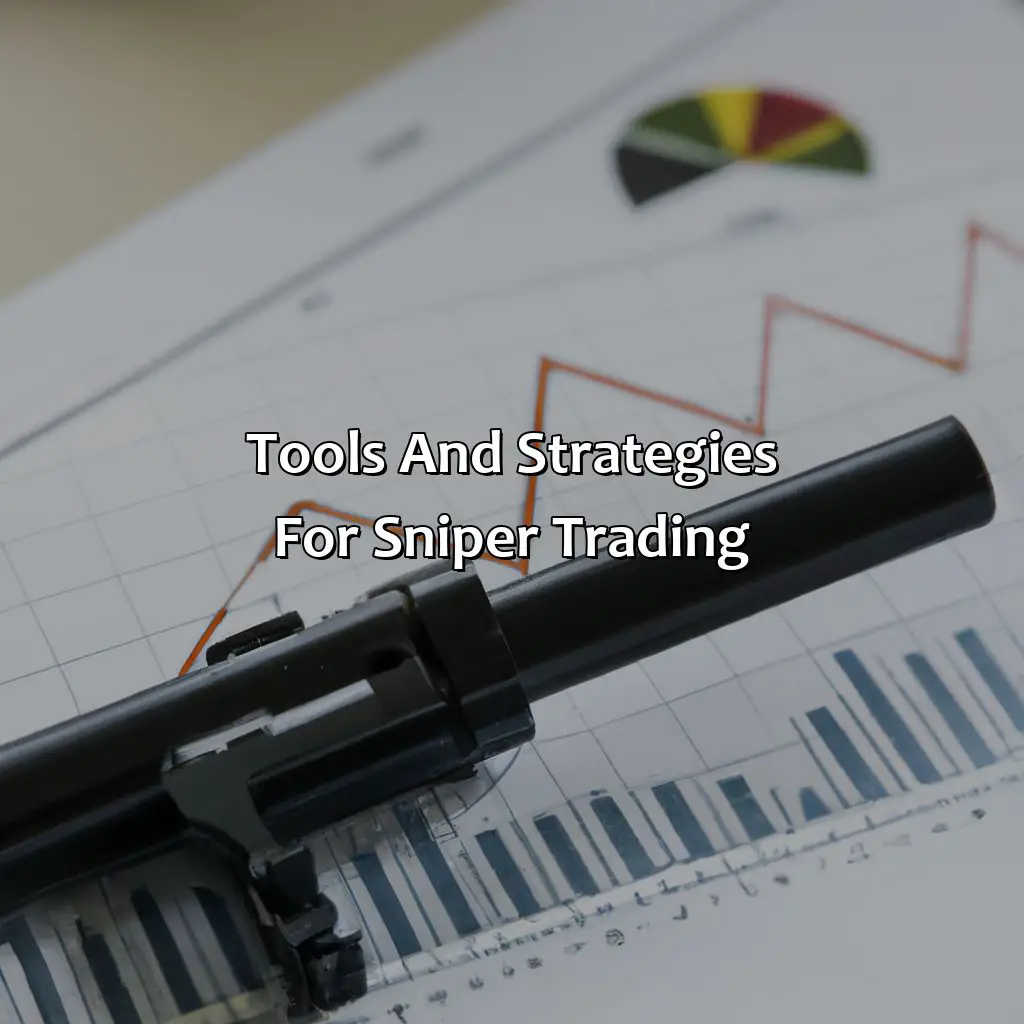
Photo Credits: forexbrokerreport.com by Brian Young
Want to know about sniper trading? We got you! We split this into four parts: Technical analysis, fundamental analysis, chart patterns, and indicators – they’re all included! Get tips on price action, breakout, pullback, trend-following, mean reversion, scalping, position, swing, day trading, and trading software. It’s all here!
Technical Analysis
Understanding Market Trends through Technical Analysis
Technical analysis is a method of analyzing market trends by examining price action on charts. By evaluating chart patterns and indicators, traders can identify potential entry and exit points for profitable trades. This approach is particularly effective for sniper trading, as it requires a keen eye for detail and the ability to react quickly to changing market conditions.
Through technical analysis, traders can gain insights into the behavior of different markets and make informed decisions based on historical data. By identifying key chart patterns, such as support and resistance levels, traders can determine where price movements are likely to occur. Additionally, traders can use a variety of indicators, such as moving averages and oscillators, to track momentum and trend strength.
To make the most of technical analysis in sniper trading, it’s important to stay up-to-date with the latest trends and tools. Traders should be constantly refining their skills through practice and research. When selecting a market to trade in, traders should always examine that market’s historical data to gain an understanding of its behavior over time.
To further enhance their technical analysis skills, traders may also want to consider using automated trading platforms or software tools designed specifically for sniper trading. These tools can help streamline the process of identifying viable trades while reducing risk and maximizing potential rewards.
Ultimately, mastering technical analysis requires patience, discipline, and a willingness to learn from experience. With the right combination of skills and strategies in place, however, any trader can become an expert sniper trader capable of making consistent profits in today’s dynamic markets.
Adding fundamental analysis to your trading strategy is like giving your sniper rifle a high-powered scope – it gives you the trader’s edge.
Fundamental Analysis
Fundamental analysis is a method of evaluating securities by analysing the underlying economic and financial factors. This involves studying various economic indicators, news events and market sentiment to determine the intrinsic value of an asset.
Traders often use fundamental analysis as it can provide them with a unique edge in the market. By understanding the underlying financial health of a company or economic landscape, traders can make informed decisions about which assets to invest in.
In addition to studying financial reports and economic data, fundamental analysis also includes examining social factors that could impact an asset’s value, such as changes in government policies or consumer trends.
One trader who successfully utilised fundamental analysis is Warren Buffett. In his early days of investing, he would read through annual reports from businesses and examine companies’ financial statements to identify undervalued assets. This focus on fundamental analysis proved successful for him and has been a key component of his investment philosophy ever since.
Chart patterns are like a sniper’s scope, helping to identify precise entry and exit points for trades through technical analysis and price action.
Chart Patterns
Identifying and utilizing chart patterns is a critical aspect of technical analysis in trading. These patterns are unique formations on price charts that show specific market conditions. Here is a table to understand the common types of chart patterns used in sniper trading:
| Chart Pattern | Description | Use in Trading |
|---|---|---|
| Head and Shoulders | A bearish trend reversal pattern, with three peaks where the middle peak is higher than the other two. | Identifying the end of an uptrend signal and a potential downtrend entry point. |
| Double Top/Bottom | A bearish found at the peak of an upward trend or bullish found at the bottom of a downward trend pattern, formed when price tests the same resistance/support level twice before failing to break through it. | Indicating either a reversal or continuation signal within a trading strategy. |
| Triangle Patterns | Bullish or bearish depending on how they form- ascending triangle (bullish), symmetrical triangle (neutral), descending triangle (bearish) | Highlighting sideways price action and when converting into consideration with other analytical tools, possible entry/exit points can be predicted successfully. |
Another useful technical analysis tool is chart pattern recognition which helps traders find ideal entry/exit points for trades, by understanding unique price movements.
The use of chart patterns while analyzing price action shall only give traders up-to-date information about market trends, but traders should conduct meticulous research on trend analysis as well as monitoring possible developments that may impact potential return rates.
Exploring new strategies incorporating technical indicators such as Moving Average Convergence Divergence (MACD), Relative Strength Index (RSI) or Bollinger Bands coupled with realistic trade scenarios using demo accounts can help prepare for live trading.
In early periods of economic stagnation and high volatility, Jesse Livermore had struggled with uncertainties and losses before understanding fluctuations within markets through data assessment during his time.
If you can read indicators like a sniper reads wind, you’ll be hitting your entry and exit points with deadly accuracy.
Indicators
To effectively make decisions while sniper trading, traders often rely on various analytical tools and techniques, including technical analysis. Indicators are formulas that aid in the interpretation of price action data, providing a visual representation of trends, entry points, exit points, and other crucial information for traders. Technical indicators can be based on chart patterns, trend analysis, or price action and can be used to make informed trading decisions in real-time.
Indicators allow traders to recognize potential trade setups quickly and efficiently by providing an objective measure of market conditions. The most commonly used indicators include moving averages, oscillators, and volume-based indicators. Traders often customize these indicators by adjusting the input parameters to better suit their trading style or preferences.
Furthermore, it is important to note that indicators should not be the sole source of information while making trading decisions. They should always be combined with other forms of analysis such as fundamental analysis or chart patterns to get a comprehensive understanding of market conditions.
Pro Tip: When using technical indicators for sniper trading, it’s crucial to test them over historical data first before applying them on live trades. This will allow traders to fine-tune their settings and discover which indicator configurations work best for their preferred markets and trading styles.
Practice and experience are key to becoming a sniper trader, so start small, focus on emotional control, and always learn from your mistakes.
Practice and Experience

Photo Credits: forexbrokerreport.com by Eric Williams
Gaining practice and experience is key to becoming a great sniper trader. To do this, try Demo Accounts to simulate trading and understand your trading psychology and emotional control. It’s also helpful to engage in live trading with small amounts. This will help you self-improve and learn from mistakes.
Benefits of using Demo Accounts, Simulated Trading and Live Trading with Small Amounts are discussed in this article.
Demo Accounts
Demo accounts are trial trading accounts offered by brokers in the financial markets. They offer a simulation of live trading conditions without requiring real money.
- Demo accounts allow traders to get familiar with the platform and test their strategies before trading real funds.
- They help traders build confidence in their skills and decision-making, resulting in better emotional control when trading real money.
- With simulated trading, traders can observe how different market scenarios can affect their trades without risking real money.
- Demo accounts also offer an opportunity for beginners to learn more about trading psychology and how to handle emotions that arise during real trades.
- Using demo accounts regularly can help improve a trader’s overall performance as they gain experience and practice.
It is essential to remember that using demo accounts does not guarantee success in actual trading. Still, it provides a low-risk space for practicing strategies and mastering essential skills before entering the markets with live capital.
A Real-Life Story
Many successful traders recommend starting with demo accounts before entering the markets. One such person is Rich Friesen, who advises aspiring traders on developing excellent emotional control while making crucial decisions under pressure.
Rich had been heavily involved in equities futures trades when he started developing his own proprietary trade systems. He did much research and learned from other skilled mentors’ techniques, including trade flow analysis, volume analysis, fundamental factors, coupled with technical levels like Fibonacci retracements even before simulating these techniques on demos.
Today, his most significant achievement comes from fostering positive culture by creating an experiential learning environment through programs that provide validity around what it takes to make effective decisions under stress. By establishing training programs that teach methodology under ideal or practice trade set-ups precisely matches those micro-skills you need to uphold when applying them during peak pressure moments – becoming an effective sniper trader!
Practice makes profitable, so start with demo accounts, move on to simulated trading, and only when confident, try live trading with small amounts.
Simulated Trading
Simulated Trading, a crucial step to become a sniper in trading, refers to using virtual money to practice trading without any risk. This method enables traders to test their strategies and skills in a simulated environment before depositing real money into the market.
By utilizing demo accounts or simulated trading platforms, traders can gain practical knowledge and troubleshoot issues they may face while live trading. However, as the simulation is devoid of emotions one might feel while live trading with real money, one should not rely on this method entirely.
To achieve success through simulated trading, traders must set goals and develop effective strategies using technical or fundamental analysis. They should also regularly monitor their performance and adjust accordingly.
But do not get complacent with only performing trades on a demo account. To see how your strategy performs in the absence of simulated artificiality, try live trading with small amounts.
Incorporating different tools like indicators or chart patterns, coupled with practice and experience gained from simulated trading, will fuel your progress towards achieving your goal of becoming a successful sniper trader. Don’t miss out on this opportunity to hone your skills!
Small amounts, big lessons: Live trading is all about mastering trading psychology, emotional control, and continuous self-improvement by learning from mistakes.
Live Trading with Small Amounts
Live trading with a smaller investment amount is crucial in the development of trading psychology and emotional control. By starting small, traders can learn from their mistakes, improve their skills, and make more profitable decisions. Practicing with a demo account or simulated trading can provide valuable experience, but nothing compares to live trading with real money on the line. Proper risk management and discipline are key factors in making successful trades with small amounts.
Pro Tip: When live trading with small amounts, focus on one or two markets at first and avoid over-trading to minimize risks.
Five Facts About How To Become A Sniper In Trading:
- ✅ To become a sniper in trading, you must have a deep understanding of technical analysis. (Source: Investopedia)
- ✅ Sniper trading involves entering and exiting trades quickly, with a high degree of accuracy. (Source: Trading Strategy Guides)
- ✅ Risk management is an essential component of sniper trading, as it often entails holding positions for shorter periods. (Source: Warrior Trading)
- ✅ Developing discipline and patience is critical to becoming a successful sniper trader. (Source: The Balance)
- ✅ Backtesting and analyzing market patterns is a necessary step in mastering sniper trading. (Source: Investopedia)
FAQs about How Do You Become A Sniper In Trading?
How do you become a sniper in trading?
To become a sniper in trading, you need to develop a deep understanding of market dynamics, be patient, and have a disciplined approach to trading. It requires a significant amount of experience, knowledge, and skill to identify profitable trade opportunities and execute trades with precision.
What are the qualities of a good sniper trader?
A good sniper trader has keen observation skills, is patient, disciplined, and has a deep understanding of market dynamics. They have the ability to identify profitable trades and have the courage to execute them with precision, even when it involves taking calculated risks.
What steps should one take to become a sniper trader?
To become a sniper trader, you first need to educate yourself about the markets, hone your analytical skills, and practice trading on a demo account before transitioning to live trading. It’s important to develop a trading strategy that’s based on your personal goals and risk tolerance and to continually refine and improve it over time.
What are the benefits of being a sniper trader?
Being a sniper trader allows you to make highly profitable trades with minimal risk and minimal time spent monitoring the markets. It enables you to achieve your financial goals in a disciplined and precise manner while minimizing losses and maximizing gains.
What are the risks of being a sniper trader?
The main risk of being a sniper trader is missing out on potential profitable trades due to a highly selective approach. Additionally, if you’re not disciplined or patient, you may be tempted to enter trades prematurely or exit them too soon, leading to missed opportunities or losses.
Is sniper trading suitable for everyone?
No, sniper trading is not suitable for everyone. It requires a certain level of experience, skill, and discipline, and may not be suitable for those who are risk-averse or don’t have the time or resources to devote to trading. It’s important to understand your personal goals and risk tolerance before deciding whether or not to pursue sniper trading.


